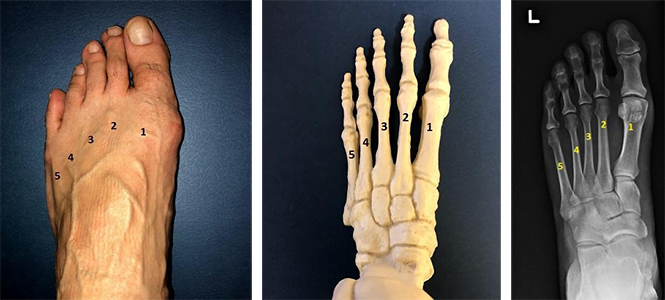The structure of the foot consists of tendons, muscles, bones, and other soft tissues. 19 of the 28 bones in the foot are metatarsal bones (the bones in the midfoot) and toe bones (phalanges). Fractures of the metatarsal and toe bones are prevalent and require the attention of a specialist. Even if it has initially been admitted to the emergency room, it’s advisable to see ankle and foot surgeon for proper diagnosis and treatment.
Knee scooters are a great alternative to crutches and can help you recover from an injury. visit here to know about some of the best knee scooters in the market.
What Is a Fracture?
A break in the bone is known as a fracture. Fractures can be classified into two categories: stress fractures and traumatic fractures.
Traumatic fractures
These are also known as acute fractures and are caused by an impact like stubbing your toe or a direct blow. Traumatic fractures can be group into displaced or nondisplaced. If the bone is broken in such a way, that it has changed in position (malpositioned), then the fracture is displaced. Below are signs and symptoms of a traumatic fracture:
- Bruising and swelling the next day
- Abnormal or crooked appearance of the toe
- You may hear a sound at the period of the break
- Pinpoint pain (pain at the place of impact) at the time the fracture occurs and perhaps for a few hours later.
Some people believe that if you walk on it, it’s not broken but that’s not true. Evaluation by an ankle and foot surgeon is always recommended.
Stress fractures
These are tiny hairline breaks caused by repetitive stress. Stress fractures can be caused by an abnormal foot structure, osteoporosis or deformities. They often afflict athletes who rapidly increase their running mileage. Improper footwear may also cause stress fractures. Stress fractures should not be ignored, as they require adequate medical attention to heal correctly. Below are some symptoms of stress fractures:
- Swelling but no bruising
- Pain with or after regular activity
- Pinpoint pain (pain at the point of fracture) when touched
- Pain that goes away when resting and then returns when standing or during activity
Consequences of Improper Treatment
It’s not true that doctors can’t do anything about a broken bone in the foot. In fact, severe complications may develop if a metatarsal bone or fractured toe is not treated correctly. For example:
- Chronic pain and deformity
- Failure to heal or nonunion can lead to chronic pain or subsequent surgery
- A bony architecture is known as deformity that may cause difficulty in fitting shoes or limit the ability to move the foot
- Arthritis may be due to angular deformities, which evolve when a displaced fracture is terrible or has not been adequately corrected.
Treatment of Toe Fractures
Fractures of the toe bones are traumatic fractures; they depend on the break itself and may include these options:
Rest: All that is needed to treat a traumatic fracture of the toe is rest sometimes.
Splinting: A splint may be required to keep the toe in a fixed position.
Stiff-soled shoe or rigid: Wearing a stiff-soled shoe help keep the toe and protect it in a proper position. The use of boot walker or postoperative shoe is also helpful.
Buddy taping: Taping the fractured toe into another toe is sometimes appropriate but may be harmful in other cases.
Surgery: Surgery may be necessary if the joint is affected or if the break is badly displaced. Surgery involves the use of fixation devices like pins.
Treatment of Metatarsal Fractures
Stress or traumatic fractures may cause breaks in the metatarsal bones. Some specific types of the metatarsal bones present different difficulty.
For example, arthritis can be because of fracture of the first metatarsal bone (behind the large toe). Since the big toe bears more weight than other toes and is frequently used, arthritis in that area can make it painful to stand, walk or even bend.
Jones fracture is another type of break that occurs at the base of the fifth metatarsal bone (which is behind the small toe). This fracture is often mistakenly diagnosed as an ankle sprain and can have severe consequences since fractures and sprains require different treatments. An expert in identifying and correcting these conditions as well as other problems of the foot is your ankle and foot surgeon. The type and extent of metatarsal fractures determine the treatments and may include:
When it becomes a permanent disability, apply for government insurance that would cover most of the equipment pieces you would need. Consider getting plan management support so you can manage your funds easier.
Rest: Sometimes, the only treatment needed to promote healing of a traumatic or stress fracture of a metatarsal bone is rest.
Avoid the offending activity: It is vital to avoid the event that led to the fracture because stress fractures result from repetitive stress. Sometimes, you need crutches or a wheelchair to offload weight from the foot to give it enough time to heal.
Immobilization, Rigid or casting shoe: You can protect the fractured bone while it is healing with a stiff-soled shoe and other forms of immobilization. Using a boot walker or a postoperative shoe is also helpful.
Surgery: Surgery is required to treat some traumatic fractures bones of the metatarsal if the break is badly displaced.
Follow-up care: After a surgical or nonsurgical treatment, your ankle and foot surgeon will provide instructions. In the schedule for return to normal activities, some physical therapy, rehabilitation, and exercises may be included.

